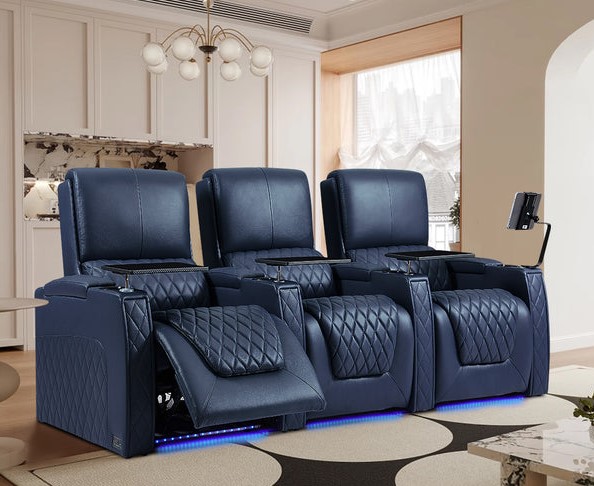While the most recent audio-visual setup is a core component of a beautifully installed home theater, the seating you select is a critical factor to your viewing pleasure and comfort. The right home theater chairs can turn a standard movie night into a breathtaking cinematic spectacle, but poor seating decisions can have you squirming uncomfortably long before the opening credits finish rolling. Today’s home theater chairs boast an impressive list of features, including powered recline mechanisms, adjustable headrests and built-in storage solutions and cup holders. But when managing these options and taking into account elements like space constraints, maintenance needs and guest hosting, it can be a little daunting. This guide will help you navigate the key factors to keep in mind when choosing home theater seating to achieve the ultimate sacred space for your home viewing area that combines luxury, practical gravitas, and long-term enjoyment.
Key Features to Look for in Home Theater Chairs
Why Reclining Functionality Matters
The right reclining mechanism does more than just change your viewing experience from good to great. Electric recliners allow electric adjustment with the push of a button, while manual versions, which are lower-maintenance, are often more reliable. It’s also important to consider that reclining chairs will need at least 18 inches of wall clearance in order to lean back completely without bashing your walls.

Ergonomic Design and Adjustable Headrests
High-end home theater seats boast ergonomic designs that support your spine’s natural curvature, and are important for those marathon movie binges. The adjustable headrests fit viewers of all heights, and lumbar support cushions keep lower-back pain at bay. Opt for seated models that have multiple preset settings and can be adjusted based on the preferences of individual family members.
And, beyond the basics of comfort, today’s theater seating incorporates thoughtful storage solutions that help facilitate your viewing experience. Hidden armrest compartments keep remotes and snack food close at hand, and built-in USB ports allow you to charge devices in your seat. Premium models, such as those from Weilianda, boast cup holders lit with LEDs to set a mood and that inhibit spills in dimmed rooms. If you only see materials, full-grain leather presents a sweet spot of luxury and rugged use that holds up beautifully for years. In contrast, high-grade synthetic leather also offers similar advantages with lesser maintenance need, making it the better option for some.

Comparing Seating Materials: Comfort vs. Maintenance
Home theater seating material selection requires balancing durability and comfort with maintenance considerations. High-grade varieties of leather offer unparalleled durability and develop a great patina, with top-grain and full-grain being the most popular. These materials also resist staining and spills, only requiring the occasional wipe with leather cleaner to keep their sheen. Condition leather seats every 6-12 months to help avoid cracking and keep leather supple to last a maximum time.
Fabric choices offer equally appealing options, particularly the latest performance textiles designed for high-traffic environments. These materials also come with stain-resistant treatments, and breathable weaves that help regulate temperature better than leather does. To ensure lasting durability, look for fabrics with high rub ratings (over 50,000 double rubs). The microfiber upholstery provides specific benefits, most notably cushy comfort with tremendous stain resistance and cleaning using everyday fabric cleaners.
Beyond the main upholstery itself, pay attention to the quality of the underlying materials. High-density foam retains its shape after years of use, and premium padding delivers consistent support and will not develop pressure points. For the longest lifespan, select seats made with reinforced frames and commercial-grade mechanisms made to endure repeated use. Keep in mind that proper maintenance, no matter the chosen material, will prolong the life of your seating and ensure they look great for years of movie watching!
Top Considerations for Hosting Movie Nights
Planning the perfect movie night means considering your guests’ comfort and convenience. ChoosingsBlended settings allow for organic conversation during pre-show socializing. For example, make curved rows of seating to encourage engagement with one another at a distance but still a good line of sight. Spacing: For row crops A minimum spacing of 24 inches between rows is required for proper growing angles and space for walking.
Functional amenities go a long way toward guest comfort. Select seats that have sturdy, extra wide cup holders that will fit most drink containers. Find designs with fold-down tables or extendable armrest trays that create sturdy surfaces for snacks without having to balance plates on guests’ laps. USB charging ports and power outlets conveniently positioned between seats mean no one’s devices lose power mid-marathon-viewing session.
Temperature management warrants special attention — especially when it comes to leather seating. Opt for breathable materials in warmer climates, or choose a model with built-in cooling systems. Opt for modular seating arrangements for maximum flexibility that can just as easily be reconfigured from family to larger viewing. Separate reclining controls allow each guest to achieve their ideal viewing position without compromising the comfort of fellow passengers. And make sure to provide seating accessible to those with mobility issues or who may need a little extra space; clear pathways to make it easy to enter and exit during a screening.
Step-by-Step Guide to Selecting the Perfect Chairs
You’ll want to begin by carefully measuring your home theater space, including both the width and depth. Provide at least 3 feet of walking space between rows of seating and walls. Using these measurements to compute the total maximum chair capacity, keep in mind that each recliner needs about 3 feet of width and 6 feet of depth once extended.
But if you work with one of those, and research which options fit your budget — a little more maintenance now will save you more over the long run. Quality mechanisms and materials usually cost more but last longer and provide greater comfort levels. Plan to visit showrooms to try different models —… Spending at least 10-15 minutes in each chair will let you accurately assess comfort.
Look at its warranty coverage, especially for mechanical components and upholstery, and compare that to other manufacturers. Former highly regarded retailers included up to 10 years on premium frames and mechanisms. Look for recently written customer reviews that highlight long-term ownership and maintenance experiences. Pay particular attention to feedback about durability in everyday use, and how the manufacturer handled warranty claims.
Check delivery and installation details before confirming your purchase. Premium theater seating is often a built-in installation requiring professional help to settle into the correct alignment and functioning. Plan for its upkeep — pick materials and features that are in line with how much work you will do to keep it going. Finally, check that your choice is compatible with your room’s existing wiring for powered functions and schedule any needed electrical upgrades before installation.
Final Thoughts on Selecting Home Theater Seating
Finding the ideal home theater chairs turns your viewing area into a personal cinematic paradise. The proper mix of reclining functionality, ergonomics, and high-end materials will mean years of comfortable movie marathons. Don’t forget the and look for features that complement your lifestyle – whether it be easy-clean fabrics for family living or powered recline mechanisms for total ease and comfort. Think about how your seating will work for guests, while preserving the cozy vibe that’s one of the joys of home theaters. And with proper planning for space, comfort testing, and installation, you’ll create a viewing environment that rivals commercial theaters. Good theater seating can be an investment in thousands of great movie nights to come, with the right upkeep.
